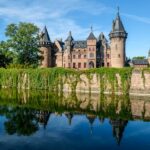ICELAND TRAVEL GUIDE

Iceland is a captivating travel destination known for its stunning landscapes, including geysers, hot springs, waterfalls, glaciers, and volcanic terrain. Here are some highlights and tips for traveling there:
- Golden Circle: This popular tourist route includes three primary attractions: Þingvellir National Park, Geysir geothermal area, and Gullfoss waterfall. It’s a great introduction to Iceland’s natural wonders.
- Blue Lagoon: This geothermal spa near Reykjavik is famous for its milky-blue waters and is a must-visit for relaxation and rejuvenation. Remember to book tickets in advance as it can get crowded.
- Reykjavik: Iceland’s capital city offers a vibrant cultural scene, with museums, galleries, and a lively nightlife. Don’t miss Hallgrímskirkja church for its unique architecture and panoramic views of the city.
- Northern Lights: Iceland is one of the best places in the world to witness the aurora borealis, especially during the winter months. Consider visiting between September and April for the best chance of seeing this natural phenomenon.
- Glacier Hiking and Ice Caving: Explore Iceland’s icy landscapes by going on guided glacier hikes or tours of ice caves. These experiences offer a unique perspective on the country’s geological features.
- Waterfalls: Iceland is home to numerous breathtaking waterfalls, including Seljalandsfoss, Skógafoss, and Dettifoss. Each waterfall has its own charm and is worth a visit.
- Road Trips: Renting a car and embarking on a road trip along the Ring Road (Route 1) is one of the best ways to explore Iceland’s diverse scenery at your own pace. Just be prepared for changing weather conditions and rugged terrain.
- Local Cuisine: Try traditional Icelandic dishes like hákarl (fermented shark), skyr (a type of yogurt), and Icelandic lamb. Reykjavik also has a thriving food scene with a variety of restaurants serving international cuisine.
- Wildlife Watching: Keep an eye out for Icelandic wildlife, including puffins, whales, seals, and Arctic foxes. There are plenty of opportunities for birdwatching and whale watching tours around the coastline.
- Respect Nature: While exploring Iceland, remember to respect the environment and follow Leave No Trace principles. Stay on designated paths, avoid disturbing wildlife, and dispose of waste responsibly.

Renting a car for your Iceland road trip
Renting a car for an Iceland road trip is a popular and convenient option for travelers looking to explore the country’s stunning landscapes at their own pace. Here are some tips and considerations for renting a car in Iceland:
- Book in Advance: Especially during peak tourist seasons (summer months), it’s advisable to book your rental car well in advance to secure the vehicle type you prefer and to potentially benefit from early booking discounts.
- Choose the Right Vehicle: Consider the type of terrain you’ll be driving on. While most of Iceland’s main roads are paved, some attractions may require driving on gravel or F-roads (mountain roads). A 4×4 or SUV might be necessary for certain routes, especially if you plan to visit remote areas or venture into the highlands.
- Insurance Options: Iceland’s weather can be unpredictable, and road conditions can vary. Make sure your rental car has comprehensive insurance coverage, including protection against gravel damage and sand and ash protection, which can be essential in Iceland’s volcanic environment.
- Fuel Stations: While there are fuel stations in most populated areas, it’s essential to plan your refueling stops, especially if you’re venturing into remote regions. Keep in mind that fuel prices can be higher in rural areas.
- Road Conditions and Driving Safety: Iceland’s weather and road conditions can change rapidly, so always check the weather forecast and road conditions before setting out. Drive cautiously, especially on gravel roads, and be prepared for strong winds, sudden changes in visibility, and wildlife crossings.
- Navigation: Make sure you have a reliable GPS or navigation app, as some areas in Iceland may lack cell phone coverage. Additionally, consider renting a Wi-Fi hotspot device to stay connected while on the road.
- Pack Essentials: Pack essentials such as warm clothing, sturdy footwear, a first-aid kit, water, snacks, and a fully charged mobile phone. It’s also a good idea to carry a paper map as a backup in case of GPS or electronic device failure.
- Roadside Assistance: Familiarize yourself with the emergency contact numbers provided by your rental car company. Iceland’s emergency services can be reached by dialing 112 in case of accidents or emergencies.
- Respect Traffic Laws and Nature: Observe speed limits, road signs, and regulations, and always yield to oncoming traffic on single-lane bridges. Additionally, adhere to designated parking areas and avoid damaging fragile natural environments.

Hiking on a Glacier, say what?!
Yes, you read that right! Hiking on a glacier is an incredible and unique experience that allows you to explore Iceland’s icy landscapes up close. Here’s what you can expect from a glacier hiking adventure:
- Guided Tours: Glacier hiking tours in Iceland are typically led by experienced guides who are knowledgeable about the terrain and safety procedures. They provide necessary equipment such as crampons, ice axes, helmets, and safety harnesses.
- Safety First: Safety is paramount when hiking on a glacier. Before setting out, guides will brief you on safety procedures, including how to use the equipment properly and how to navigate the icy terrain safely.
- Stunning Scenery: Glacier hiking offers breathtaking views of Iceland’s rugged beauty, including towering ice formations, deep crevasses, and mesmerizing blue ice caves. It’s a photographer’s dream come true!
- Physical Challenge: Glacier hiking can be physically demanding, requiring a reasonable level of fitness and agility. You’ll be walking on uneven terrain and navigating icy slopes, so be prepared for a workout.
- Educational Experience: Guides often provide fascinating insights into the glacier’s formation, geology, and the effects of climate change. You’ll learn about the glacier’s history and significance to Iceland’s landscape.
- Weather Considerations: Iceland’s weather can be unpredictable, even on glaciers. Be prepared for changing weather conditions, including strong winds, snowfall, and sudden drops in temperature. Dress warmly in layers and bring waterproof clothing.
- Environmental Awareness: Glaciers are fragile ecosystems, and it’s essential to tread lightly and minimize your impact on the environment. Follow your guide’s instructions, stay on designated paths, and avoid disturbing wildlife.
- Once-in-a-Lifetime Experience: Hiking on a glacier is a bucket-list-worthy adventure that offers a unique perspective on Iceland’s natural wonders. It’s an experience you’ll never forget and a highlight of any trip to Iceland.
Stunning Icelandic Waterfalls and Volcanic Craters
Iceland is home to some of the world’s most stunning waterfalls and volcanic craters, each with its own unique charm and beauty. Here are a few notable examples:
Waterfalls:
- Gullfoss: Located in the Golden Circle route, Gullfoss is one of Iceland’s most iconic waterfalls. It cascades down two tiers into a narrow canyon, creating a breathtaking spectacle, especially during sunny days when rainbows often form in the mist.
- Seljalandsfoss: This picturesque waterfall is famous for its unique feature – a path that allows visitors to walk behind the cascading water curtain, providing a memorable and immersive experience. It’s located along the South Coast of Iceland.
- Skógafoss: Another impressive waterfall along Iceland’s South Coast, Skógafoss plunges 60 meters (197 feet) over a cliff into a small pool below. Visitors can climb a staircase next to the waterfall for panoramic views of the surrounding landscape.
- Dettifoss: Known as Europe’s most powerful waterfall, Dettifoss is located in Vatnajökull National Park in northeastern Iceland. Its thundering waters plummet into a deep canyon, creating an awe-inspiring sight.
- Godafoss: Translating to “Waterfall of the Gods,” Godafoss is located in northern Iceland and is renowned for its horseshoe-shaped cascade. According to legend, it was named when Iceland converted to Christianity, and statues of Norse gods were thrown into the falls.
Volcanic Craters:
- Kerid: Located in southern Iceland along the Golden Circle route, Kerid is a volcanic crater lake known for its striking red volcanic rock and vivid blue-green water. Visitors can walk around the crater rim or descend to the lake’s shore.
- Víti Crater: Found in the Askja caldera in the remote Highlands of Iceland, Víti is a volcanic crater filled with bright blue geothermal water. It’s a popular destination for hiking and bathing in the warm waters.
- Eldborg Crater: Situated on the Snæfellsnes Peninsula in western Iceland, Eldborg is a perfectly symmetrical volcanic crater that offers panoramic views of the surrounding lava fields and mountains. A hike to the top rewards visitors with stunning vistas.
- Grabrok Crater: Located in the West of Iceland, Grabrok is a volcanic crater with three smaller craters at its peak. A short hike to the top provides panoramic views of the surrounding landscape, including lava fields and distant mountains.







